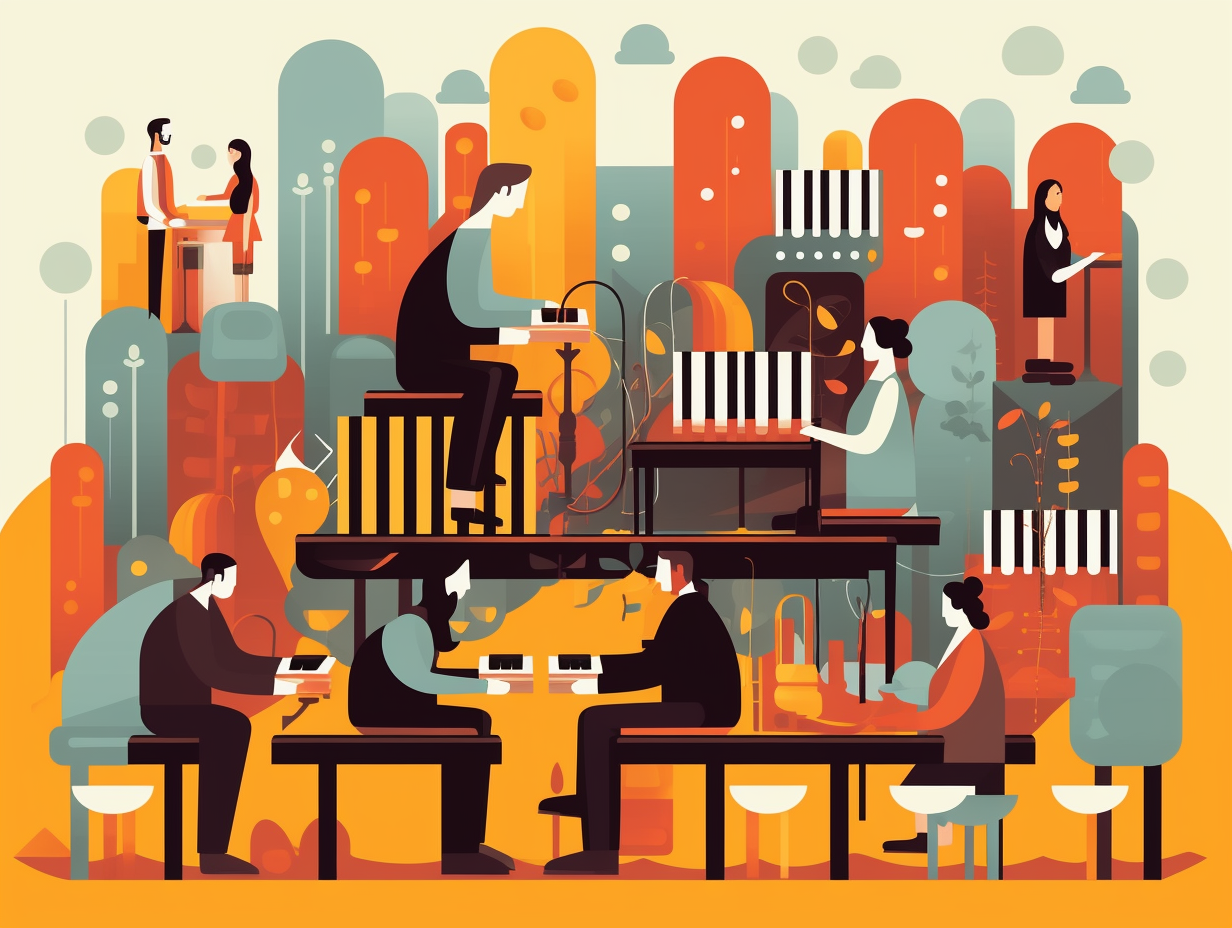Uncover the Secrets: Top 14 Intriguing and Entertaining Fun Facts About Keyboards

1. 'E' - The MVP of English
Oh keyboard, my keyboard: wherefore art thou 'E' so omnipresent? As the reigning MVP of the English language and a stealthy chameleon, it's no surprise that the letter 'E' keeps us on our toes and fingers tap-dancing across the keys: Not only is it the most commonly used letter in English, but it can represent the schwa sound, the long /ɜ:/ sound, and even the short /ɪ/ sound. Plus, it sometimes goes incognito as a silent partner in words like centre and determine, while still making its presence felt by affecting other vowels' pronunciation. Truly a key player, the 'E' never skips a beat!
Source => englishlanguagethoughts.com
2. Birth of the Shift Key
Before there was a "caps lock" warzone in the comment section, there was a major innovation that set the stage for keyboard battlegrounds: The Remington 2 typewriter brought us the shift key, allowing for both upper and lowercase characters, revolutionizing typewriter design and manufacturing, paving the way for modern computer keyboards we know and love (or hate) today.
Source => antiquetypewriters.com

Did you know the touch screen technology we love on our smartphones dates back to the 1960s? Discover how E.A. Johnson and Dr. G Samuel Hurst made poking and swiping cool way before it was mainstream.
=> Fun Facts about Computers
3. QWERTY and the Typewriter Jam
Before text messages and autocorrect blessed and cursed our lives, there was a jam-sesh between an innovative chap and a touchy typewriter: Christopher Latham Sholes, the maestro of the QWERTY keyboard, meticulously fine-tuned the layout in 1868 by separating the most commonly used letter pairs in English to reduce typewriter jams. As a cherry on top, he threw in the shift key to let eager typists tango between uppercase and lowercase letters, and thus, the QWERTY keyboard danced its way to commercial success.
Source => pabook.libraries.psu.edu
4. KALQ Keyboard - Speedy Thumbs Unite
When our thumbs aren't hitchhiking to text-ville or digging through snack-bags of inefficiency: behold, the KALQ keyboard layout, conceived by Montana Tech, University of St Andrews, and the Max Planck Institute for Informatics to boost touchscreen typing speed by 34%, specifically tailored for Android-based smartphones and thumb-typing aficionados (last seen in a 2013 beta app).
Source => en.wikipedia.org

5. The 88-Key Piano Master
Pianists beware: if your piano isn't taking you high enough, it's time to slide on up to the 88 key master! This key-friendly behemoth boasts a smooth octo-octofest: from the deepest depths of C1 to the sky-scraping highs of C8, the 88-keys of the modern piano effortlessly glide through eight octaves. Middle C, also known as C4, sits proudly in the center as the defining boundary between bass and treble clef territories. Just when you thought it couldn't get any wilder, gasp in awe at the potential 102-key expansions, reaching down to a rumbling C0 and up to a stratospheric F8 for the most adventurous of musical explorers.
Source => grandpianopassion.com
6. No Jams for QWERTY
Once upon a jam, there was a key-master named Christopher Sholes who sought to rescue typists from their inky fate, by making sure their keys never got too friendly: Little did Mr. Sholes know that his 1868 invention of the QWERTY keyboard layout, ingeniously designed to prevent keys on mechanical typewriters from jamming by spreading common letter pairs apart, would not only outlive the machines it was created for but also become a standard for modern keyboard layouts yet untouched by the perils of jam!
Source => gastongazette.com
7. AZERTY: QWERTY's French Cousin
Once upon a corkboard, the QWERTY gang had a French cousin who went rogue and flipped the script – er, the keys: Enter the fascinating world of the AZERTY keyboard! This peculiar layout, used primarily in France and Belgium, traces its history back to the late 1800s and boasts a complex lineage chock full of twists, tweaks, and alternates for different regions. But in the end, AZERTY and its first-row arrangement of A, Z, E, R, T, and Y reign supreme, even getting a modern makeover to better accommodate multilingual typists.
Source => en.wikipedia.org
8. F and J: Braille Chic
In a touching display of tactile fashion, the F and J keys on your keyboard have accessorized themselves by sporting some dapper little bumps: These stylish "home row locator bumps" ensure that your fingers become runway-ready and elegantly slide into their touch typing positions without needing directions from your peepers.
Source => tutorialspoint.com
9. Barbara Blackburn - Queen of Speed Typing
Step aside, speed demons: Barbara Blackburn held the title of world's fastest typist, peaking at an unbelievable 212 WPM on a Dvorak keyboard. Not only that, but she also starred in an Apple commercial and faced off against David Letterman's production assistant, proving there's more to keyboard mastery than just QWERTY.
Source => en.wikipedia.org

10. Windows Key + V = Life-Changing Clipboard
In a world where the Ctrl + C, Ctrl + V combo is more iconic than peanut butter and jelly, the mighty Keyboard Gods have blessed the realm of Windows users with a newfound power, unimaginable in the days of Windows 95: with the October 2018 Update, pressing Windows Key + V unveils a majestic clipboard history, forever changing the way we copy and paste our deepest thoughts and most treasured cat memes.
Source => digitaltrends.com
11. Apollo's Space-Age Typewriter Buddy
Before Siri and Alexa, there was Buzz and Neil's chatty typewriter companion on their celestial slumber party: The Display Keyboard (DSKY) played a crucial role in Apollo missions, allowing astronauts to communicate with computers in real-time. They punched in "verb-noun" pairs to access information or give commands, making DSKY the ultimate space-age chatterbox buddy.
Source => airandspace.si.edu
12. Slow-Mo Typing by Design
Those early typewriters must have been the first mechanical slowpokes, or maybe they just loved playing an eternal rendition of "The Typist Who Slowed Down His Fingers": QWERTY keyboards were actually designed to reduce typing speed and prevent the jamming of keys in early typewriters, ensuring that commonly used letters stayed far apart to avoid any key clashes and infuriating errors.
Source => daskeyboard.com
13. The Esc Key - Bob Bemer's Panic Saver
Feeling trapped in your digital dungeon and in dire need of a way out? Thank Bob Bemer and his anxious brilliance for that trusty Esc key: Originally invented in 1960 as a panic button for computer programmers switching between codes, it later evolved into an emergency exit from sticky situations. Ironically, Bemer was driven by his own fears to create the escape route and even forewarned the world about the Y2K bug in the '70s, ensuring our modern-day digital warriors have a quick and easy exit strategy when things go haywire.
Source => nytimes.com
14. Ergonomic Keyboards to the Rescue!
Fear not valiant desk jockeys, with bent wrists and strained shoulders, for ergonomic salvation is nigh: a study by Cornell University reveals that using a negatively tilted keyboard significantly reduces carpal tunnel pressure, while fully split designs ease shoulder and neck tension, turning the battlefield of office ergonomics into a veritable playground.
Source => nytimes.com
Related Fun Facts




















